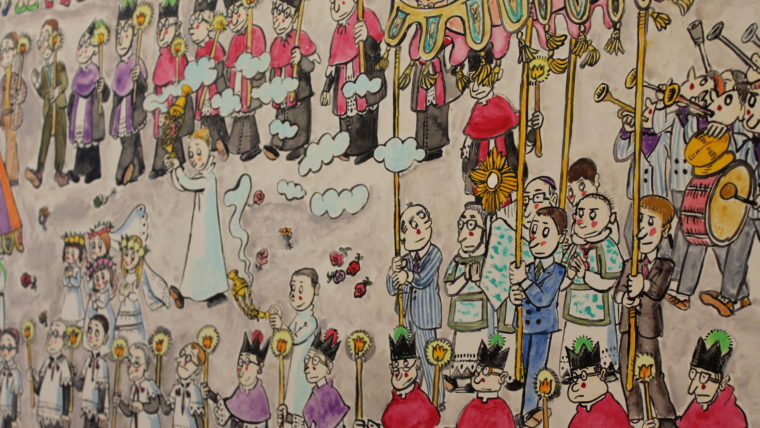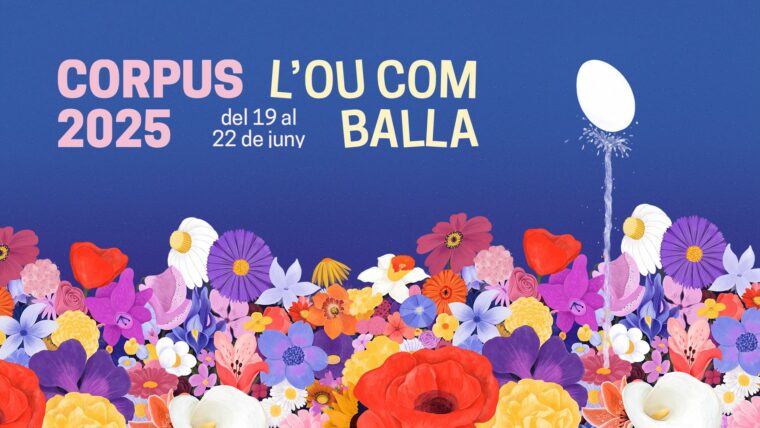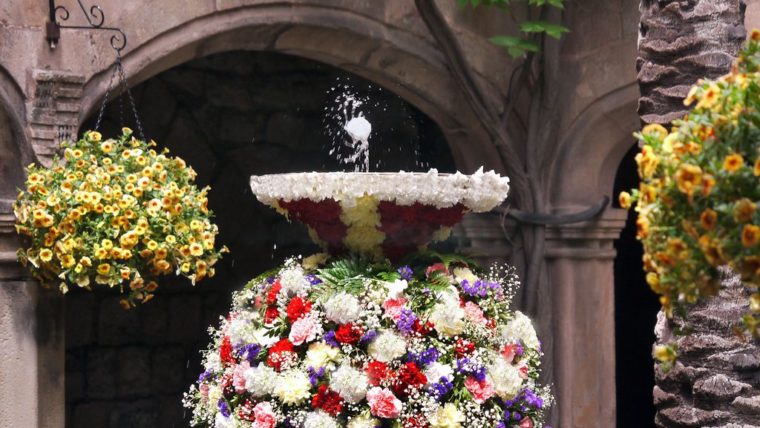The popular religious festivity of Corpus Christi in Barcelona
The festivity of Corpus Christi is a Catholic celebration to revere the Holy Communion. This is one of the city’s oldest and most distinguished festivities, noted for its popular and participatory elements. Barcelona will be dressing up to celebrate this festival, which this year takes place from 19 June (Corpus Christi) to 22 June. This 2025 the Dancing Egg recovers water with the end of the drought decree and after a few years of being carried out in an adapted way.

Corpus Christi (‘body of Christ’ in Latin) is a Catholic festival in reverence to Holy Communion. This festivity on the liturgical calendar falls on the Thursday following the Octave of Trinity. This feast day, medieval in origin and instituted by Pope Urban IV in 1262, was celebrated by the Catholic Church to publicly venerate the Sacrament of the Eucharist and to exalt the doctrine of the Body of Christ to those who denied it. The festival became more universal in the Christian world from 1316 onwards, following a papal bull by Pope John XXII. The tradition spread throughout Europe, gaining importance over time. From that moment, it became widespread across Europe and even in the 21st century, six centuries later, it is still a hugely important religious, social, cultural and festive event. In 2021, the Generalitat de Catalunya declared Corpus Christi in Barcelona a Heritage Festival of National Interest.
It was many years ago that Barcelona City Council decided to revive the festival of Corpus Christi, one of the oldest and most vibrant festivals in the city. And it did so based on two of the most popular and participative aspects of the Festival, which are fruit of the collective legacy of the people of Barcelona: the procession and the Dancing Egg. The end of spring sets the scene for a festival where floral decorations and festive events transform the city. Some historic buildings are decorated for the occasion, along with some streets and facilities, making Barcelona’s Corpus Christi celebrations an ideal time to go for a stroll and discover Barcelona in a different way. This year’s programme includes religious celebrations as well as other events linked to popular culture.
The procession, which has been held in Barcelona since 1320, has huge significance for the city and city residents. Barcelona and Girona were the second cities in the world to celebrate Corpus Christi with a procession (other places in Catalonia, such as Valls, did so in 1319). These Corpus Christi processions were the forerunners to the current parades, which form part of numerous local festivals in towns and cities today. Since 1992, Barcelona City Council has been organising this vibrant, festive procession, which comes in addition to the procession of the faithful, which precedes it, and which sets off after the mass of Corpus Christi, following the Monstrance containing the Consecrated Host to the throne of King Martin. The procession usually takes place on the Sunday following the feast of Corpus Christi (this year, 22 June). The various elements in the parade set off from the City Hall courtyard, accompanied by music and following a strict order. After the presentations and formal dances, the festival procession makes its way along Carrer del Bisbe to Pla de la Seu. There, the ecclesiastical entourage joins the festive procession.
The route and times for the procession on 22 June is as follows:
- At 6.00 pm, mass of Corpus Christi in Pla de la Seu, presided over by the Archbishop of Barcelona, cardinal Joan Josep Omella.
- At 6.50 pm, display of the Falcons de Barcelona and dance of the new Casa de la Caritat and Corpus Christi Giants in Plaça de Sant Jaume.
- At 7.00 pm, the festive procession sets off with the Seguici Popular, or communal procession, and other elements, from Barcelona City Hall. Route: Plaça de Sant Jaume, Carrer del Bisbe , Plaça Nova and Carrer del Arcs.
- At 7.45 pm, the Corpus Christi procession begins. Route: Avinguda de la Catedral, Plaça Nova, Carrer dels Boters, Plaça de Cucurulla, Carrer del Pi, Plaça de Sant Josep Oriol, Plaça del Pi, Carrer del Cardenal Casañas, La Rambla, Carrer de Ferran, Plaça de Sant Jaume, Carrer del Bisbe, Plaça Nova and Avinguda de la Catedral.
- At around 9.00 pm, arrival of the monstrance, dance of the Àliga of the City and dance of the City Giants on Avinguda de la Catedral.
The Dancing Egg is one of the most unique celebrations in Barcelona, which has been a part of the feast of Corpus Christi since 1636. The Dancing Egg consists of making a hollow eggshell dance on a jet of water, in a fountain decorated with an abundance of flowers and plants. This image has been associated with the figure of the Host when it is elevated, but the fact that the egg alludes to fertility and plenitude and that this custom takes place at the time of Corpus Christi could suggest other interpretations and readings. Beyond the discussion about its origins, the truth is that the tradition has become firmly rooted in Catalonia, the only place in the world where the Dancing Egg occurs today. The celebration forms part of the city’s collective tradition. This year, the Dancing Egg recovers water for Corpus Christi from fountains and springs in cloisters, courtyards and gardens, after the end of the drought decree. In the city, there are numerous places where you can enjoy the Dancing Egg. In 2025, you’ll find the Dancing Egg in the Ateneu Barcelonès, the Arxiu de la Corona d’Aragó – Palau Lloctinent, the Arxiu Històric de la Ciutat – Casa de l’Ardiaca, the Capitania General, the Rubió i Lluch Gardens, the Cathedral, the Museu Frederic Marès, the Maritime Museum, the Basílica de la Puríssima Concepció, Carrer de la Llibertat, the Castellers de Barcelona, the Can Deu Civic Centre, the El Sortidor Civic Centre, the Centre of Gràcia, the Escolàpies Llúria, the Espai Albert Musons, the oratory of Sant Felip Neri, Sant Martí Park, the parish church of Àngel Custodi, the parish church of Santa Maria del Taulat, the Reial Monestir de Santa Maria de Pedralbes, the Seminari Conciliar de Barcelona, the Taller Sant Camil, the Torre de la Sagrera, among other locations. MORE INFORMATION AND LOCATIONS HERE.
Another of the characteristic expressions of Corpus Christi are the floral mosaics. These are beautiful and natural works of temporary art. Works which would be trodden on by the Corpus Christi procession and the festive entourage or parade. Yet in the past they were actually respected by all the participants in the procession, with the exception of those carrying the Monstrance, as these represented the essence of Corpus Christi. Though the mosaics are not exclusive to Corpus Christi, this is when they are the most likely to be seen. At first, they were simply meant to transform the festive space and release a pleasant scent, especially when they were trodden on by the passing procession. This year, Barcelona will be adorned with floral mosaics which can be seen in various locations in the city. MORE INFORMATION AND LOCATIONS OF ALL FLORAL MOSAICS HERE.
Also worth noting is the recent proliferation of bell ringers in a number of the city’s neighbourhoods, that announce the celebration and fill Barcelona with the sound of their chimes.




